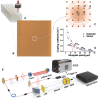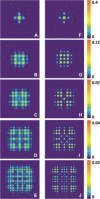Experimental two-dimensional quantum walk on a photonic chip
- PMID: 29756040
- PMCID: PMC5947980
- DOI: 10.1126/sciadv.aat3174
Experimental two-dimensional quantum walk on a photonic chip
Abstract
Quantum walks, in virtue of the coherent superposition and quantum interference, have exponential superiority over their classical counterpart in applications of quantum searching and quantum simulation. The quantum-enhanced power is highly related to the state space of quantum walks, which can be expanded by enlarging the photon number and/or the dimensions of the evolution network, but the former is considerably challenging due to probabilistic generation of single photons and multiplicative loss. We demonstrate a two-dimensional continuous-time quantum walk by using the external geometry of photonic waveguide arrays, rather than the inner degree of freedoms of photons. Using femtosecond laser direct writing, we construct a large-scale three-dimensional structure that forms a two-dimensional lattice with up to 49 × 49 nodes on a photonic chip. We demonstrate spatial two-dimensional quantum walks using heralded single photons and single photon-level imaging. We analyze the quantum transport properties via observing the ballistic evolution pattern and the variance profile, which agree well with simulation results. We further reveal the transient nature that is the unique feature for quantum walks of beyond one dimension. An architecture that allows a quantum walk to freely evolve in all directions and at a large scale, combining with defect and disorder control, may bring up powerful and versatile quantum walk machines for classically intractable problems.
Figures




References
-
- Aharonov Y., Davidovich L., Zagury N., Quantum random walks. Phys. Rev. A 48, 1687–1690 (1993). - PubMed
-
- Childs A. M., Farhi E., Gutmann S., An example of the difference between quantum and classical random walks. Quantum Inf. Process. 1, 35–43 (2002).
-
- Ambainis A., Quantum walks and their algorithmic applications. Int. J. Quantum Inf. 1, 507–518 (2003).
-
- Shenvi N., Kempe J., Whaley K. B., Quantum random-walk search algorithm. Phys. Rev. A 67, 052307 (2003).
-
- Childs A. M., Goldstone J., Spatial search by quantum walk. Phys. Rev. A 70, 022314 (2004).
Publication types
LinkOut - more resources
Full Text Sources
Other Literature Sources

